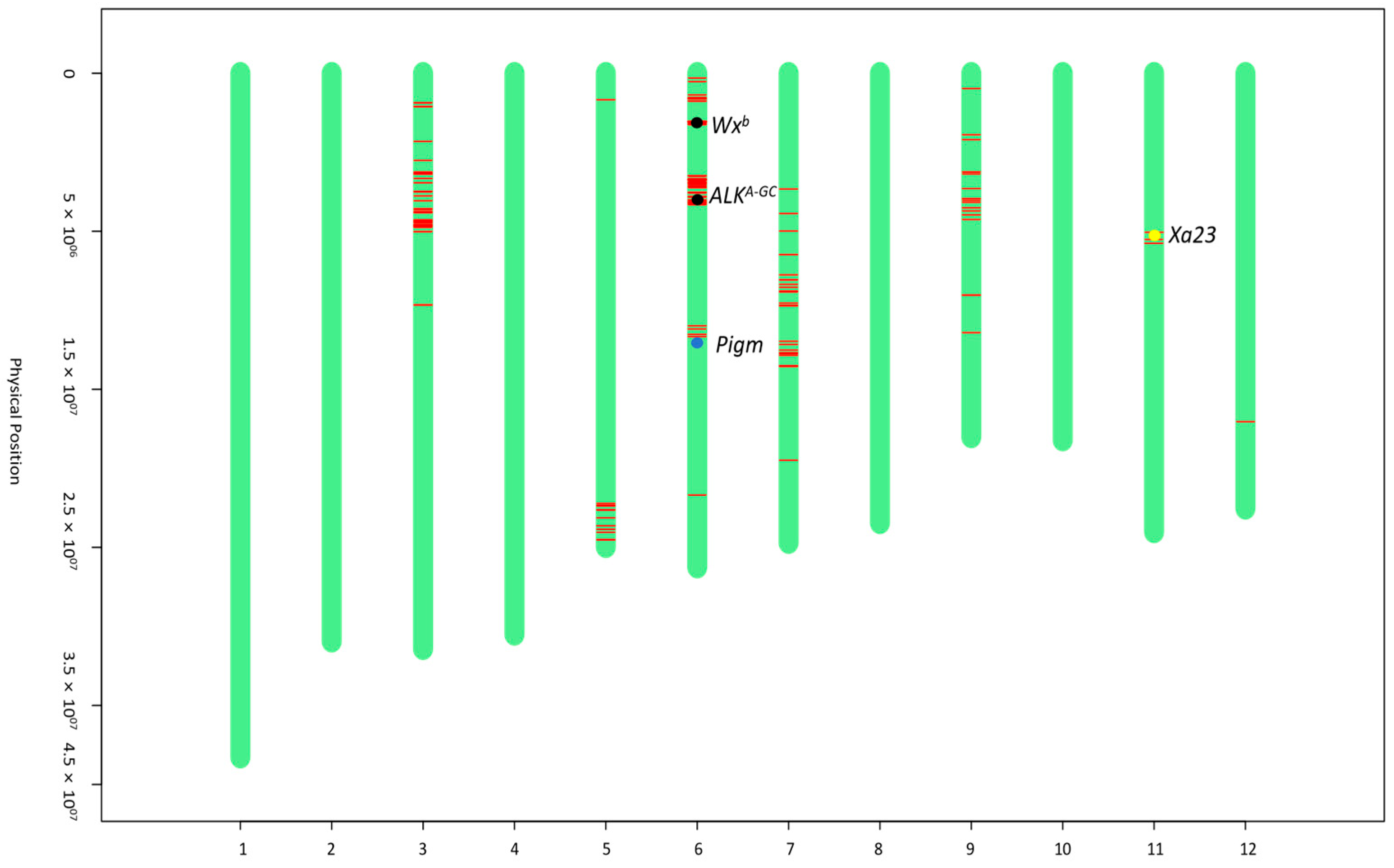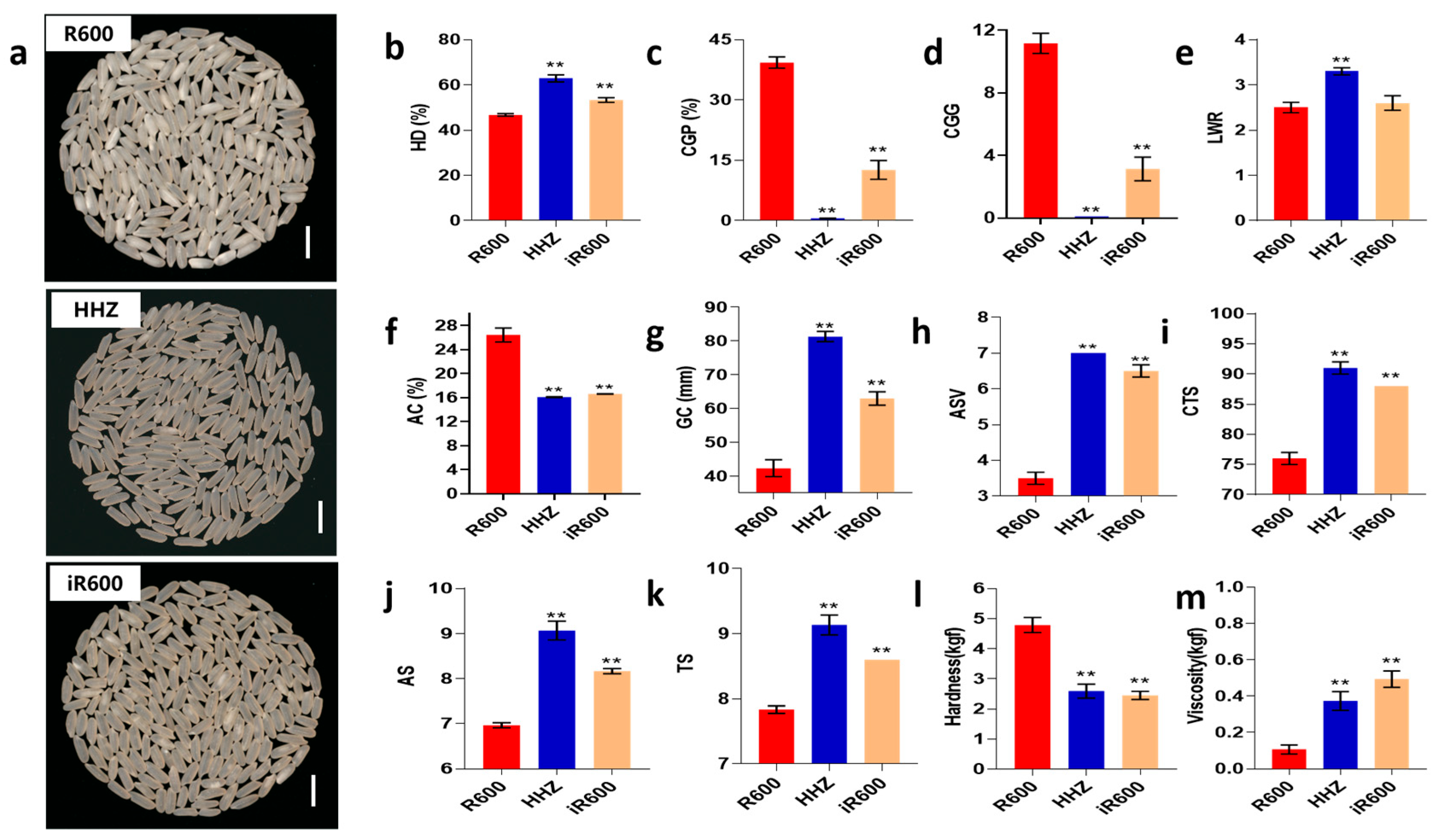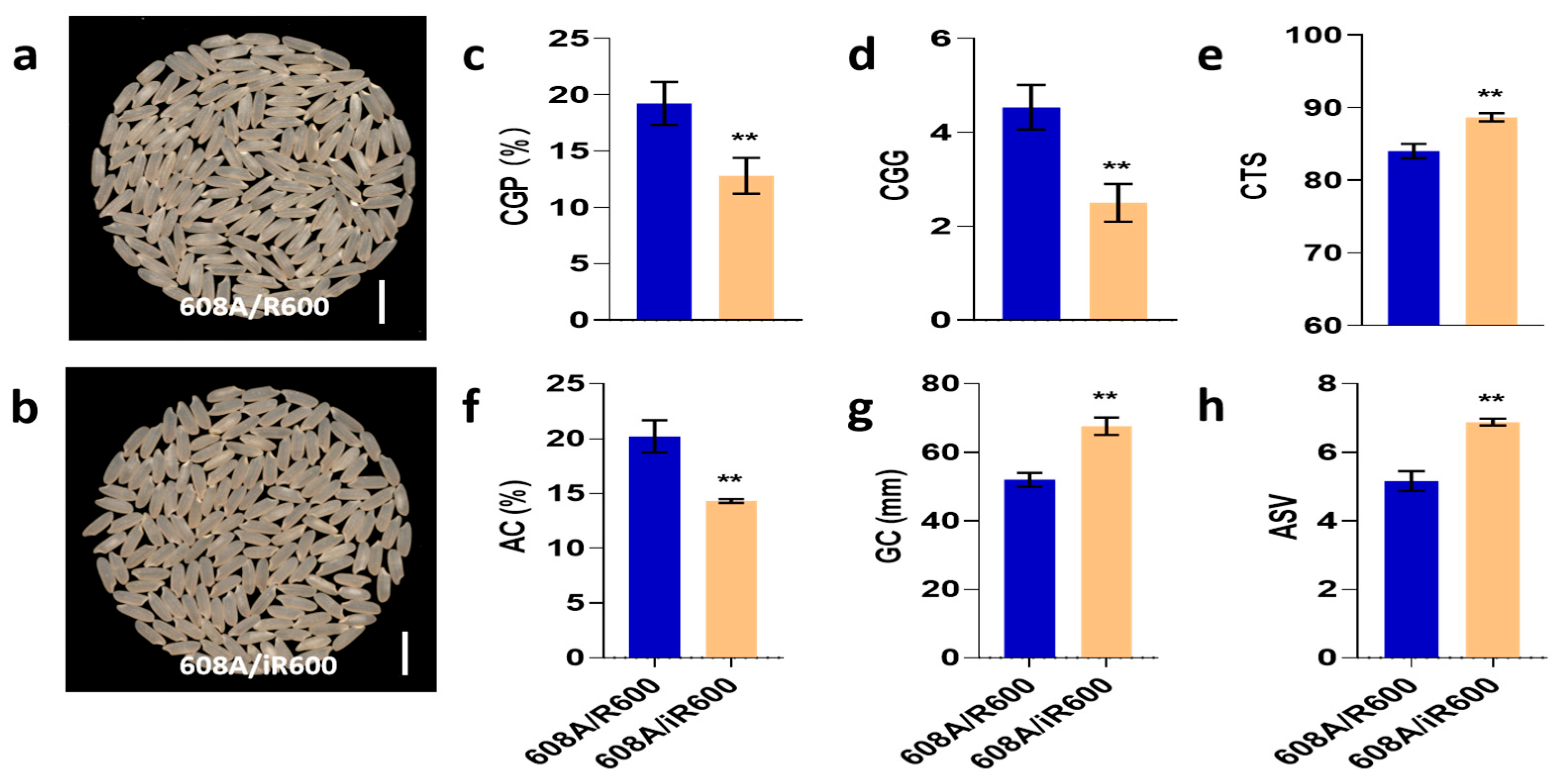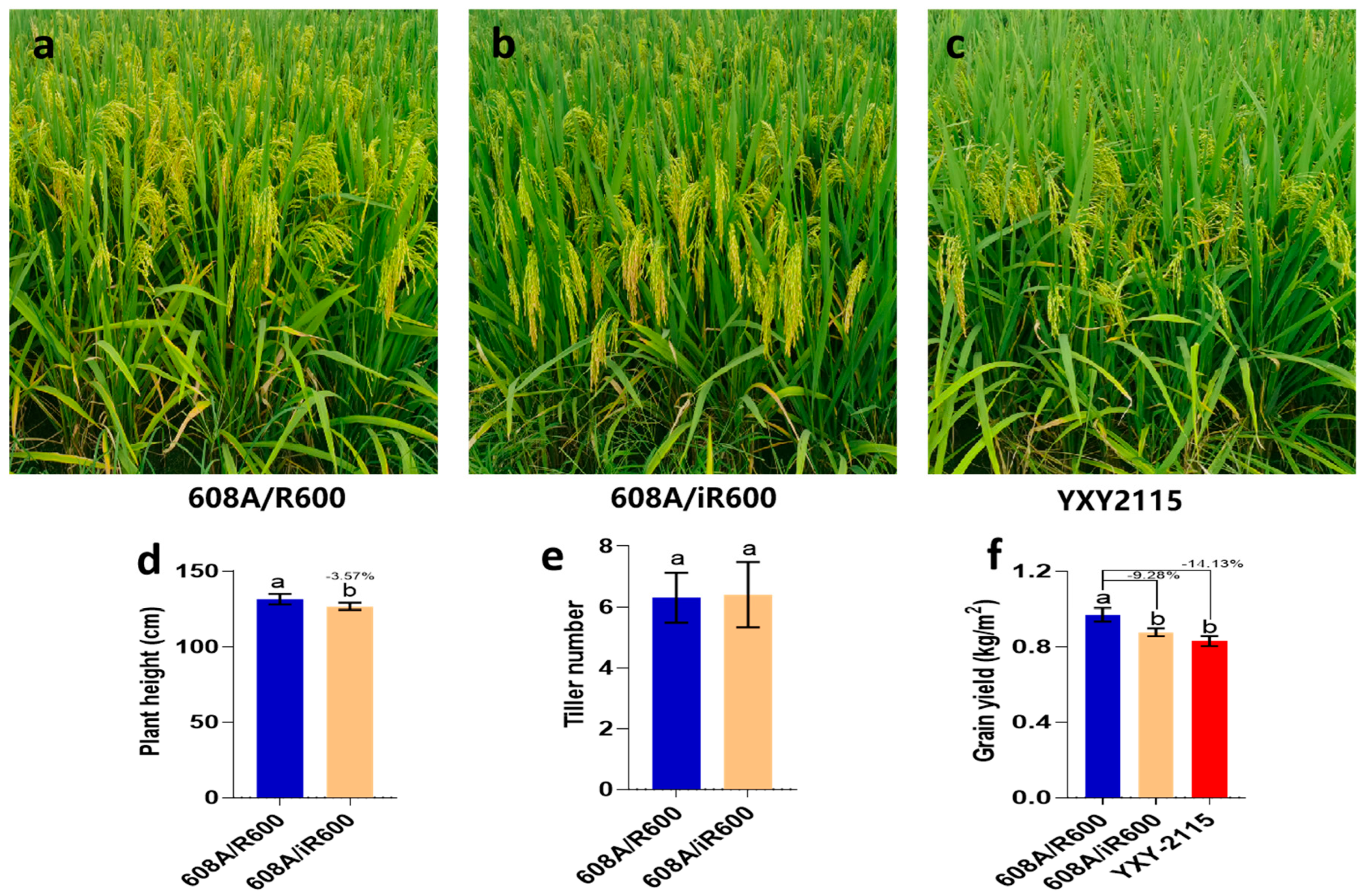Improvement of Quality and Disease Resistance for a Heavy-Panicle Hybrid Restorer Line, R600, in Rice (Oryza sativa L.) by Gene Pyramiding Breeding
Abstract
:1. Introduction
2. Materials and Methods
2.1. Plant Materials
2.2. Population Development and Breeding Selection Procedure
2.3. Marker-Assisted Selection
2.4. Genetic Background Analysis
2.5. Evaluation of Rice Blast Resistance
2.6. Evaluation of BB Resistance
2.7. Evaluation of Agronomic Traits
2.8. Evaluation of ECQ Quality Traits
2.9. Statistical Analysis
2.10. Abbreviations
3. Results
3.1. Development of iR600 Lines by Pyramiding Pigm, Xa23, Wxb, and ALKA-GC
3.2. Comparison of Grain Quality between iR600 and R600
3.3. The RVA Profile of iR600 Starch
3.4. Evaluation of iR600 Resistance to Rice Blast and BB
3.5. Agronomic Trait Performance of iR600
3.6. Application of iR600 in Hybrid Rice Breeding
4. Discussion
5. Conclusions
Supplementary Materials
Author Contributions
Funding
Institutional Review Board Statement
Informed Consent Statement
Data Availability Statement
Conflicts of Interest
References
- Cheng, S.H.; Cao, L.Y.; Zhuang, J.Y.; Chen, S.G.; Zhan, X.D.; Fan, Y.Y.; Zhu, D.F.; Min, S.K. Super hybrid rice breeding in China: Achievements and prospects. J. Integr. Plant Biol. 2007, 49, 805–810. [Google Scholar] [CrossRef]
- Ren, D.; Ding, C.; Qian, Q. Molecular bases of rice grain size and quality for optimized productivity. Sci. Bull. 2023, 68, 314–350. [Google Scholar] [CrossRef] [PubMed]
- Zheng, X.; Wei, F.; Cheng, C.; Qian, Q. A historical review of hybrid rice breeding. J. Integr. Plant Biol. 2023, 66, 532–545. [Google Scholar] [CrossRef]
- Takeda, S.; Matsuoka, M. Genetic approaches to crop improvement: Responding to environmental and population changes. Nat. Rev. Genet. 2008, 9, 444–457. [Google Scholar] [CrossRef]
- Gao, C. Genome engineering for crop improvement and future agriculture. Cell 2021, 184, 1621–1635. [Google Scholar] [CrossRef] [PubMed]
- Peleman, J.D.; Van der Voort, J.R. Breeding by design. Trends Plant Sci. 2003, 8, 330–334. [Google Scholar] [CrossRef]
- Ma, J.; Zhou, K. The relations between panicle characters of intersubspecific heavy panicle hybrid rice and vascular bundles in neck-panicle. Southwest China J. Agric. Sci. 2001, 14, 1–5. [Google Scholar]
- Ma, J.; Zhou, K.; Ma, W.; Wang, X.; Ming, D.; Yan, Z. Study on the relationship of the characteristics of vascular bundles in the first internode and grain-filling of heavy panicle type hybrid rice. Agric. Sci. China 2002, 1, 631–635. [Google Scholar]
- Tian, Z.; Qian, Q.; Liu, Q.; Yan, M.; Liu, X.; Yan, C.; Liu, G.; Gao, Z.; Tang, S.; Zeng, D. Allelic diversities in rice starch biosynthesis lead to a diverse array of rice eating and cooking qualities. Proc. Natl. Acad. Sci. USA 2009, 106, 21760–21765. [Google Scholar] [CrossRef]
- Sato, H.; Suzuki, Y.; Sakai, M.; Imbe, T. Molecular characterization of Wx-mq, a novel mutant gene for low-amylose content in endosperm of rice (Oryza sativa L.). Breed. Sci. 2002, 52, 131–135. [Google Scholar] [CrossRef]
- Hori, Y.; Fujimoto, R.; Sato, Y.; Nishio, T. A novel wx mutation caused by insertion of a retrotransposon-like sequence in a glutinous cultivar of rice (Oryza sativa). Theor. Appl. Genet. 2007, 115, 217–224. [Google Scholar] [CrossRef]
- Liu, L.; Ma, X.; Liu, S.; Zhu, C.; Jiang, L.; Wang, Y.; Shen, Y.; Ren, Y.; Dong, H.; Chen, L. Identification and characterization of a novel Waxy allele from a Yunnan rice landrace. Plant Mol. Biol. 2009, 71, 609–626. [Google Scholar] [CrossRef]
- Mikami, I.; Uwatoko, N.; Ikeda, Y.; Yamaguchi, J.; Hirano, H.-Y.; Suzuki, Y.; Sano, Y. Allelic diversification at the wx locus in landraces of Asian rice. Theor. Appl. Genet. 2008, 116, 979–989. [Google Scholar] [CrossRef] [PubMed]
- Yang, J.; Wang, J.; Fan, F.J.; Zhu, J.Y.; Chen, T.; Wang, C.L.; Zheng, T.Q.; Zhang, J.; Zhong, W.G.; Xu, J.L. Development of AS-PCR marker based on a key mutation confirmed by resequencing of W x-mp in Milky P rincess and its application in japonica soft rice (Oryza sativa L.) breeding. Plant Breed. 2013, 132, 595–603. [Google Scholar] [CrossRef]
- Zhang, C.; Zhu, J.; Chen, S.; Fan, X.; Li, Q.; Lu, Y.; Wang, M.; Yu, H.; Yi, C.; Tang, S. Wxlv, the ancestral allele of rice Waxy gene. Mol. Plant 2019, 12, 1157–1166. [Google Scholar] [CrossRef] [PubMed]
- Wang, Z.Y.; Zheng, F.Q.; Shen, G.Z.; Gao, J.P.; Snustad, D.P.; Li, M.G.; Zhang, J.L.; Hong, M.M. The amylose content in rice endosperm is related to the post-transcriptional regulation of the waxy gene. Plant J. 1995, 7, 613–622. [Google Scholar] [CrossRef]
- Li, C.; Liu, C.; Zhang, C.; Zhu, J.; Xu, X.; Zhao, F.; Huang, S.; Jin, Y.; Liu, Q. Genetic diversity of ALK gene and its association with grain gelatinization temperature in currently cultivated rice landraces from Hani’s terraced fields in Yunnan province. Acta Agron. Sin. 2017, 43, 343–353. [Google Scholar] [CrossRef]
- Gao, Z.; Zeng, D.; Cheng, F.; Tian, Z.; Guo, L.; Su, Y.; Yan, M.; Jiang, H.; Dong, G.; Huang, Y. ALK, the Key Gene for Gelatinization Temperature, is a Modifier Gene for Gel Consistency in Rice F. J. Integr. Plant Biol. 2011, 53, 756–765. [Google Scholar]
- Zhou, Y.; Zheng, H.; Wei, G.; Zhou, H.; Han, Y.; Bai, X.; Xing, Y.; Han, Y. Nucleotide diversity and molecular evolution of the ALK gene in cultivated rice and its wild relatives. Plant Mol. Biol. Rep. 2016, 34, 923–930. [Google Scholar] [CrossRef]
- Ni, D.; Zhang, S.; Chen, S.; Xu, Y.; Li, L.; Li, H.; Wang, Z.; Cai, X.; Li, Z.; Yang, J. Improving cooking and eating quality of Xieyou57, an elite indica hybrid rice, by marker-assisted selection of the Wx locus. Euphytica 2011, 179, 355–362. [Google Scholar] [CrossRef]
- Wang, Y.; Fu, X.; Gao, G.; He, Y. Improving the grain quality of Minghui63, a restorer line of rice with good quality through marker-assisted selection. Mol. Plant Breed. 2009, 7, 661–665. [Google Scholar]
- Luo, Y.; Ma, T.; Zhang, A.; Ong, K.H.; Luo, Z.; Li, Z.; Yang, J.; Yin, Z. Marker-assisted breeding of Chinese elite rice cultivar 9311 for disease resistance to rice blast and bacterial blight and tolerance to submergence. Mol. Breed. 2017, 37, 106. [Google Scholar] [CrossRef]
- Zhang, N.; Luo, J.; Rossman, A.Y.; Aoki, T.; Chuma, I.; Crous, P.W.; Dean, R.; De Vries, R.P.; Donofrio, N.; Hyde, K.D. Generic names in Magnaporthales. IMA Fungus 2016, 7, 155–159. [Google Scholar] [CrossRef] [PubMed]
- Costanzo, S.; Jia, Y. Sequence variation at the rice blast resistance gene Pi-km locus: Implications for the development of allele specific markers. Plant Sci. 2010, 178, 523–530. [Google Scholar] [CrossRef]
- Rathour, R.; Gopala Krishnan, S.; Khanna, A.; Dhatwalia, S.; Kaachra, A.; Sharma, T.; Singh, A.K. Development and validation of co-dominant gene based markers for Pi9, a gene governing broad-spectrum resistance against blast disease in rice. Mol. Breed. 2016, 36, 168. [Google Scholar] [CrossRef]
- Wang, F.; Chen, Z.; Xu, Y.; Wang, J.; Li, W.; Fan, F.; Chen, L.; Tao, Y.; Zhong, W.; Yang, J. Development and application of the functional marker for the broad-spectrum blast resistance gene PigmR in rice. Sci. Agric. Sin. 2019, 52, 955–967. [Google Scholar]
- Wu, Y.; Chen, Y.; Pan, C.; Xiao, N.; Yu, L.; Li, Y.; Zhang, X.; Pan, X.; Chen, X.; Liang, C. Development and evaluation of near-isogenic lines with different blast resistance alleles at the Piz locus in japonica rice from the lower region of the Yangtze River, China. Plant Dis. 2017, 101, 1283–1291. [Google Scholar] [CrossRef]
- Deng, Y.; Zhai, K.; Xie, Z.; Yang, D.; Zhu, X.; Liu, J.; Wang, X.; Qin, P.; Yang, Y.; Zhang, G. Epigenetic regulation of antagonistic receptors confers rice blast resistance with yield balance. Science 2017, 355, 962–965. [Google Scholar] [CrossRef]
- Fu, Z.-W.; Li, J.-H.; Gao, X.; Wang, S.-J.; Yuan, T.-T.; Lu, Y.-T. Pathogen-induced methylglyoxal negatively regulates rice bacterial blight resistance by inhibiting OsCDR1 protease activity. Mol. Plant 2024, 17, 325–341. [Google Scholar] [CrossRef]
- Ellur, R.K.; Khanna, A.; Yadav, A.; Pathania, S.; Rajashekara, H.; Singh, V.K.; Krishnan, S.G.; Bhowmick, P.K.; Nagarajan, M.; Vinod, K. Improvement of Basmati rice varieties for resistance to blast and bacterial blight diseases using marker assisted backcross breeding. Plant Sci. 2016, 242, 330–341. [Google Scholar] [CrossRef]
- Wang, C.; Zhang, X.; Fan, Y.; Gao, Y.; Zhu, Q.; Zheng, C.; Qin, T.; Li, Y.; Che, J.; Zhang, M. XA23 is an executor R protein and confers broad-spectrum disease resistance in rice. Mol. Plant 2015, 8, 290–302. [Google Scholar] [CrossRef] [PubMed]
- Xu, C.; Ren, Y.; Jian, Y.; Guo, Z.; Zhang, Y.; Xie, C.; Fu, J.; Wang, H.; Wang, G.; Xu, Y. Development of a maize 55 K SNP array with improved genome coverage for molecular breeding. Mol. Breed. 2017, 37, 20. [Google Scholar] [CrossRef] [PubMed]
- He, M.; Yin, J.; Feng, Z.; Zhu, X.; Zhao, J.; Zuo, S.; Chen, X. Methods for evaluation of rice resistance to blast and sheath blight diseases. Chin. Bull. Bot. 2020, 55, 577. [Google Scholar]
- Sun, X.; Cao, Y.; Yang, Z.; Xu, C.; Li, X.; Wang, S.; Zhang, Q. Xa26, a gene conferring resistance to Xanthomonas oryzae pv. oryzae in rice, encodes an LRR receptor kinase-like protein. Plant J. 2004, 37, 517–527. [Google Scholar] [PubMed]
- Chen, N.; Zhu, Z.; Duan, B.; Min, J.; Chen, M.; Xu, L. NY/T 595-2013 in Agricultural Industry Standard of People’s Republic of China; Standards Press of China: Beijing, China, 2013. [Google Scholar]
- He, X.; Bin, L.; Jiang, T.; Xiao, X.; Feng, Y.; Zhang, R. GB/T 22294-2008 in National Standard of the People’s Republic of China; Standards Press of China: Beijing, China, 2008. [Google Scholar]
- Luo, Y.; Rong, R.; Chen, Y.; Wu, M.; Min, J. NY 147-88 in National Standard of the People’s Republic of China; Standards Press of China: Beijing, China, 1988. [Google Scholar]
- Zeng, D.; Tian, Z.; Rao, Y.; Dong, G.; Yang, Y.; Huang, L.; Leng, Y.; Xu, J.; Sun, C.; Zhang, G. Rational design of high-yield and superior-quality rice. Nat. Plants 2017, 3, 17031. [Google Scholar] [CrossRef]
- Wang, C.; Qi, H.; Pan, H.; Li, J.; Fan, Y.; Zhang, Q.; Zhao, K. EST-markers flanking the rice bacterial blight resistance gene Xa23 and their application in marker-assisted selection. Sci. Agric. Sin. 2005, 38, 1996–2001. [Google Scholar]
- Zeng, S.Y.; Li, C.; Du, C.C.; Sun, L.T.; Jing, D.D.; Lin, T.Z.; Yu, B.; Qian, H.F.; Yao, W.C.; Zhou, Y.W.; et al. Development of specific markers for Pigm in marker-assisted breeding of panicle blast resistant japonica rice. Chin. J. Rice Sci. 2018, 32, 453. [Google Scholar]
- Rao, Y.; Li, Y.; Qian, Q. Recent progress on molecular breeding of rice in China. Plant Cell Rep. 2014, 33, 551–564. [Google Scholar] [CrossRef]
- Jiang, J.; Yang, D.; Ali, J.; Mou, T. Molecular marker-assisted pyramiding of broad-spectrum disease resistance genes, Pi2 and Xa23, into GZ63-4S, an elite thermo-sensitive genic male-sterile line in rice. Mol. Breed. 2015, 35, 83. [Google Scholar] [CrossRef]
- Deng, Y.; Ning, Y.; Yang, D.-L.; Zhai, K.; Wang, G.-L.; He, Z. Molecular basis of disease resistance and perspectives on breeding strategies for resistance improvement in crops. Mol. Plant 2020, 13, 1402–1419. [Google Scholar] [CrossRef]
- Xiao, N.; Pan, C.; Li, Y.; Wu, Y.; Cai, Y.; Lu, Y.; Wang, R.; Yu, L.; Shi, W.; Kang, H. Genomic insight into balancing high yield, good quality, and blast resistance of japonica rice. Genome Biol. 2021, 22, 283. [Google Scholar] [CrossRef] [PubMed]
- Gao, L.; Gao, H.; Li, R.; Li, D.; Zhou, M.; Yan, Q.; Zhou, W.; Zhang, J.; Deng, G. Optimization and verification of molecular markers for rice bacterial blight resistance gene Xa23. Mol. Plant Breed. 2010, 8, 660–664. [Google Scholar]
- Wang, L.; Liu, W.; Xu, Y.; He, Y.; Luo, L.; Xing, Y.; Xu, C.; Zhang, Q. Genetic basis of 17 traits and viscosity parameters characterizing the eating and cooking quality of rice grain. Theor. Appl. Genet. 2007, 115, 463–476. [Google Scholar] [CrossRef]
- Pang, Y.; Ali, J.; Wang, X.; Franje, N.J.; Revilleza, J.E.; Xu, J.; Li, Z. Relationship of rice grain amylose, gelatinization temperature and pasting properties for breeding better eating and cooking quality of rice varieties. PLoS ONE 2016, 11, e0168483. [Google Scholar] [CrossRef]
- Cai, X.L.; Wang, Z.Y.; Xing, Y.Y.; Zhang, J.L.; Hong, M.M. Aberrant splicing of intron 1 leads to the heterogeneous 5′ UTR and decreased expression of waxy gene in rice cultivars of intermediate amylose content. Plant J. 1998, 14, 459–465. [Google Scholar] [CrossRef] [PubMed]
- Chen, Z.; Lu, Y.; Feng, L.; Hao, W.; Li, C.; Yang, Y.; Fan, X.; Li, Q.; Zhang, C.; Liu, Q. Genetic dissection and functional differentiation of ALK a and ALK b, two natural alleles of the ALK/SSIIa gene, responding to low gelatinization temperature in rice. Rice 2020, 13, 39. [Google Scholar] [CrossRef]
- Tao, G.; Hong, Y.; Jie, Q.; JiaYang, L.; Bin, H.; Lin, H.X. Advances in rice genetics and breeding by molecular design in China. Sci. Sin. Vitae 2019, 49, 1185–1212. [Google Scholar]
- Gao, M.; Hao, Z.; Ning, Y.; He, Z. Revisiting growth–defence trade-offs and breeding strategies in crops. Plant Biotechnol. J. 2024, 22, 1198–1205. [Google Scholar] [CrossRef]
- Huot, B.; Yao, J.; Montgomery, B.L.; He, S.Y. Growth–defense tradeoffs in plants: A balancing act to optimize fitness. Mol. Plant 2014, 7, 1267–1287. [Google Scholar] [CrossRef]









Disclaimer/Publisher’s Note: The statements, opinions and data contained in all publications are solely those of the individual author(s) and contributor(s) and not of MDPI and/or the editor(s). MDPI and/or the editor(s) disclaim responsibility for any injury to people or property resulting from any ideas, methods, instructions or products referred to in the content. |
© 2024 by the authors. Licensee MDPI, Basel, Switzerland. This article is an open access article distributed under the terms and conditions of the Creative Commons Attribution (CC BY) license (https://creativecommons.org/licenses/by/4.0/).
Share and Cite
Wang, H.; Wang, G.; Qin, R.; Gong, C.; Zhou, D.; Li, D.; Luo, B.; Jin, J.; Deng, Q.; Wang, S.; et al. Improvement of Quality and Disease Resistance for a Heavy-Panicle Hybrid Restorer Line, R600, in Rice (Oryza sativa L.) by Gene Pyramiding Breeding. Curr. Issues Mol. Biol. 2024, 46, 10762-10778. https://doi.org/10.3390/cimb46100639
Wang H, Wang G, Qin R, Gong C, Zhou D, Li D, Luo B, Jin J, Deng Q, Wang S, et al. Improvement of Quality and Disease Resistance for a Heavy-Panicle Hybrid Restorer Line, R600, in Rice (Oryza sativa L.) by Gene Pyramiding Breeding. Current Issues in Molecular Biology. 2024; 46(10):10762-10778. https://doi.org/10.3390/cimb46100639
Chicago/Turabian StyleWang, Haipeng, Gen Wang, Rui Qin, Chengqin Gong, Dan Zhou, Deke Li, Binjiu Luo, Jinghua Jin, Qiming Deng, Shiquan Wang, and et al. 2024. "Improvement of Quality and Disease Resistance for a Heavy-Panicle Hybrid Restorer Line, R600, in Rice (Oryza sativa L.) by Gene Pyramiding Breeding" Current Issues in Molecular Biology 46, no. 10: 10762-10778. https://doi.org/10.3390/cimb46100639
APA StyleWang, H., Wang, G., Qin, R., Gong, C., Zhou, D., Li, D., Luo, B., Jin, J., Deng, Q., Wang, S., Zhu, J., Zou, T., Li, S., Liang, Y., & Li, P. (2024). Improvement of Quality and Disease Resistance for a Heavy-Panicle Hybrid Restorer Line, R600, in Rice (Oryza sativa L.) by Gene Pyramiding Breeding. Current Issues in Molecular Biology, 46(10), 10762-10778. https://doi.org/10.3390/cimb46100639



